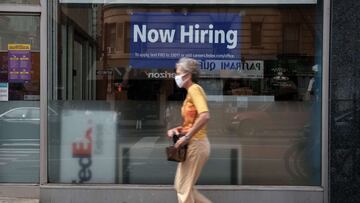Which states were ordered to reinstate unemployment benefits?
Some states attempted to abandon the extra unemployment benefits earlier than Labor Day but have been fought by people who were losing their support.


The enhanced unemployment benefits amount to an extra $300 a week and have been in place since March 2020, initially introduced with the CAREs act. As well as the extra unemployment benefits ending on Septmber 6, the PUA and PEUC support will end too. 13.2 million people are expected to lose access to the benefits.
However, the Labor Day deadline is only the federal end and 26 states had attempted to leave the schemes earlier in July. This was met with resistance from workers who were seeing their benefits stripped. Lawmakers argued that the continuation of extra benefits was discouraging people from returning to the workplace, but recent data from the July jobs report showed the states which ended early actually had a slower rate of jobs take up compared to those who continued it.
26 states (all but 1 led by GOP governors) have tried to end or reduce expanded federal unemployment benefits. They argue doing so will bring ppl back to the work and boost their economies.
— Ben Casselman (@bencasselman) August 20, 2021
Has it worked? New research suggests the answer is mostly "no."https://t.co/F4kOfNrQ5u
These are the states which successfully challenged the cancellation of the benefits in court:
- Indiana
- Maryland
- Arkansas
- Oklahoma
Other states are still having the cases deliberated, including Florida, Texas, Missouri and Tennessee. A successful result of the lawsuit would likely lead to a back payment of the missing benefits. There have also been lawsuits which have failed. The states of Louisiana, Ohio, and West Virginia have been denied by judges.
Why are they ending?
The vaccine rollout has managed to keep cases and deaths from covid-19 relatively low in the last few months. The US has of 50.9% of the population fully-vaccinated, but the speed of vaccinations has slowed to a crawl. States have begun fully reopening economies and striking down rules relating to the wearing of masks, meaning people made redundant during the pandemic are returning to the workplace.
The number of people seeking unemployment benefits fell to a pandemic low last week — the fourth drop in as many weeks. It's the latest sign that America’s job market is rebounding as employees boost hiring to meet a surge in consumer demand. https://t.co/h9CYUeeI7u
— The Associated Press (@AP) August 19, 2021
Related stories
Furthermore, the most recent unemployment figures of the Labor Department show more people are returning to work then estimated. In July, nearly 1 million workers rejoined the payroll and the unemployment rate stands at 5.4%. Before the pandemic, the unemployment rate stood at 3.5%. It could be deemed that is no longer necessary to keep the benefits as the US is tentatively returning to normal. Even a change of 1.9% represents hundreds of thousands of Americans who will be left much poorer without the extra payments if they do indeed end in a fortnight.
What other support is there?
Despite the end of these schemes, there is other federal support for those who need it. These are:
- Child Tax Credit - the extra funding for families has been a key part of Biden's legislation and is looking to be extended to 2025. It includes up to $300 of extra funding per child, per month, depending on the age of the child in question. There is no limit on applicable children.
- Supplemental Nutrition Assistance Program (SNAP) - The value of food stamps is increasing to $36.24 per person, per month. This increase is starting 1 October 2021 and is a 25% bump on the pre-pandemic level. However, it's only eligible for families at or below the poverty line.
- Eviction moratorium - The CDC order means tenants in areas of substantial or high transmission who fail to make rent or housing payments will not be evicted. This order covers 90% of the country, but only until October 3.
- Emergency Rental Assistance Program (ERAP) - This is extra assistance for households that are unable to pay rent or utilities.
Think Fed Unemployment Benefits Going Away?
— Charles V Payne (@cvpayne) August 19, 2021
Think Again
Treasury Department is re-affirming that states can use their allocations of the $350 billion in American Rescue Plan State and Local Fiscal Relief Funds to provide assistance to unemployed workers.https://t.co/GEavbcsjmr

